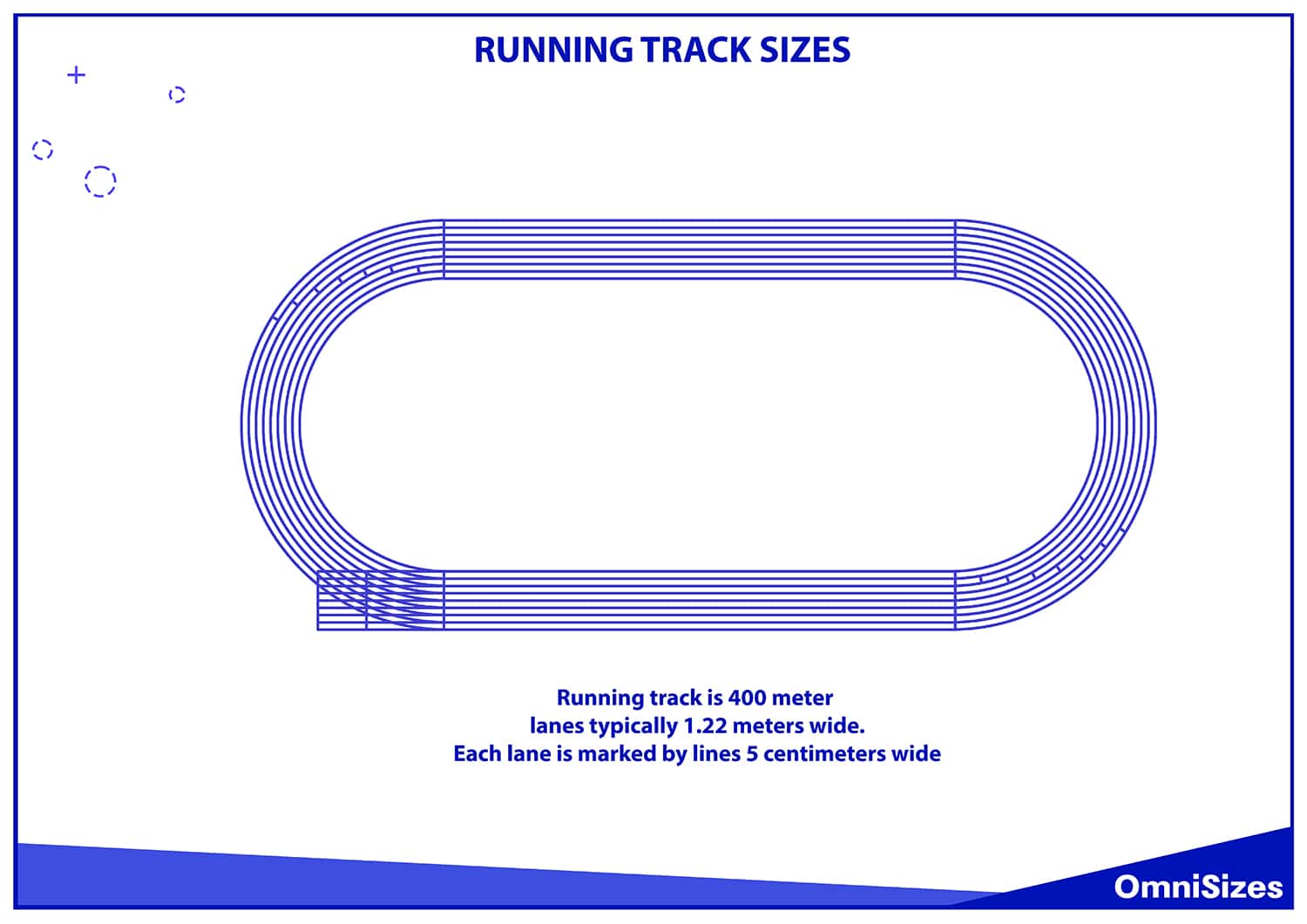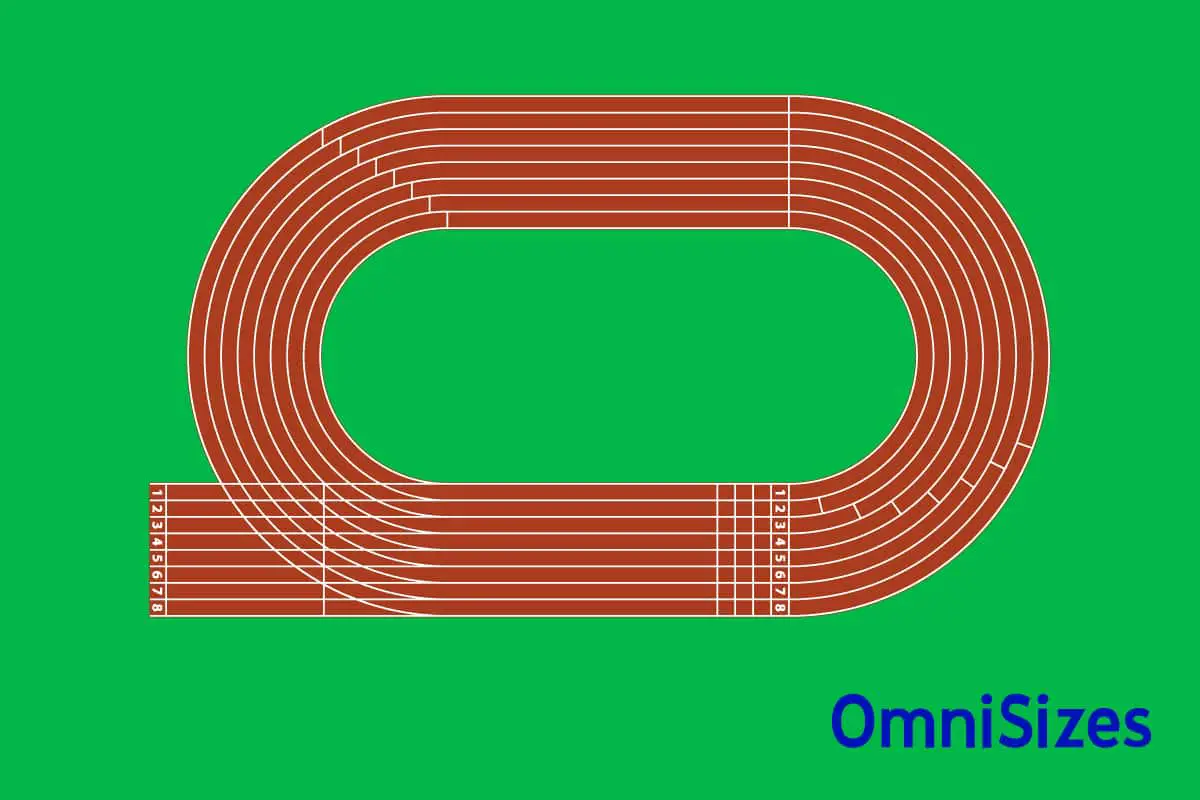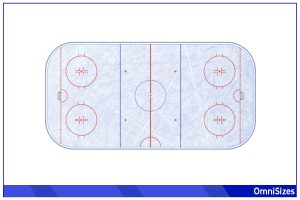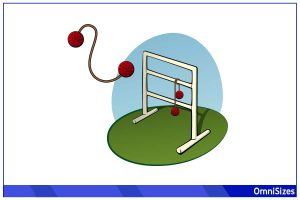Running tracks are a staple in the world of athletics, providing a stage for sprinters, distance runners, and many others to showcase their talents. Running track sizes vary in design, with each tailored to different events.
The standard size for a running track is a 400-meter oval with lanes typically 1.22 meters wide. Each lane is marked by lines 5 centimeters wide.

This guide will briefly cover the history of running tracks, as well as running track sizes, including size variations.
Historical Evolution of Track Sizes
Running tracks have a rich history dating back to ancient civilizations. The Greeks were among the first to introduce structured tracks, prominently featured in the original Olympic Games established in 776 BC. These tracks, however, varied significantly in size and shape, often designed in a straight line rather than the oval format we see today.
In Roman times, tracks evolved further. The Romans constructed more elaborate venues, like the Circus Maximus, primarily for chariot racing. These tracks were longer and had a distinct U-shape, a departure from the Greek straight-line design. However, the focus was more on spectacle rather than standardized athletic competition.
The modern era of track and field began to take shape in the 19th century. This period marked a significant shift towards standardization, driven by the establishment of athletic clubs and organized competitions. In 1850, England hosted the first modern track and field meet, but even then, track sizes varied, often dictated by the constraints of the space available.
The turning point came with the revival of the Olympic Games in 1896. Initially, there was no uniform track size even in these Games, but the need for a standardized format was increasingly recognized. The International Association of Athletics Federations (IAAF), established in 1912, played a crucial role in this. They began to define specific dimensions for tracks, particularly for international competitions.
Standard Track Dimensions
The most common running track sizes follow Olympic and IAAF guidelines.
Olympic Standard Track Size
The Olympic standard track size is a model of consistency and precision in athletics. Measuring exactly 400 meters in circumference, these tracks are designed in an oval shape, comprised of two straight sections and two semi-circles. This specific length was set to ensure uniformity across international competitions, making it easier to compare athletes’ performances worldwide.
Each lane of an Olympic track is 1.22 meters wide, with the innermost lane having a total distance of 400 meters. The distance increases slightly with each lane due to the larger circumference. This design is optimized for various track events, from sprints to long-distance races.
IAAF Regulations and Guidelines
The IAAF sets the guidelines for track dimensions, materials, and overall design (PDF). These regulations do not deviate from Olympic standards of 400 meters with 1.22-meter-wide lanes.
One key aspect is the track surface. The IAAF recommends specific types of synthetic surfaces that provide optimal traction and shock absorption (PDF). These surfaces are usually made of rubber or polyurethane compounds for durability and weather resistance.
Track Size Variations
While the standard 400-meter track is prevalent worldwide, variations exist, especially between indoor and outdoor tracks.
Indoor vs Outdoor Track Sizes
Track sizes can vary significantly, especially when comparing indoor and outdoor tracks. Indoor tracks, on the other hand, are usually shorter due to space limitations. The common length for an indoor track is 200 meters, exactly half the size of an outdoor track. This shorter length means tighter curves.
Regional Differences in Track Dimensions
In some high schools and recreational facilities, you might find tracks that are shorter than the standard 400 meters. These can range from 300 to 350 meters.
In certain regions, especially in countries with a strong heritage in athletics, tracks might be designed with additional features to support specific types of training or events. For example, some European countries have tracks with different surfaces, like cinder or clay, which were more common before the widespread adoption of synthetic surfaces.
Components of a Running Track
The components of a running track, from the lane widths to the material composition, are meticulously designed to optimize performance, safety, and functionality.
1. Lane Widths
Each lane on a standard outdoor track is 1.22 meters (about 4 feet) wide. This width is carefully chosen to balance the space needed for an athlete to run comfortably while maximizing the number of lanes within the available space. Indoor tracks, with their smaller circumference, might have narrower lanes.
2. Track Curvature
The curvature of a running track is designed with the athlete’s experience in mind. On a standard 400-meter outdoor track, the radius of the curve is approximately 36.5 meters. This measurement impacts the centrifugal force exerted on runners. In shorter indoor tracks, the curves are tighter, which can affect running technique and speed
3. Material Composition
Modern tracks are commonly made from synthetic materials like polyurethane or rubber. These materials help in reducing injuries and enhancing performance by providing a consistent, responsive surface.
4. Track Markings
Track markings include start and finish lines, staggered lines for races that start on the curve, lane lines, and exchange zones for relay races. The markings are designed for clarity and precision. They are usually painted in a contrasting color, often white, for visibility against the track surface.
5. Field Event Integration
Many running tracks are designed to accommodate field events like long jump, high jump, triple jump, pole vault, shot put, discus, and javelin throw. These areas are integrated into the overall track design, often located in the infield (the area enclosed by the track) or adjacent to it. The placement of these areas is carefully planned to ensure that field events can occur simultaneously with track events without interference.
6. Safety Features
These include adequate cushioning to reduce impact, non-slip surfaces to prevent falls, and proper drainage to avoid water accumulation. Some tracks also include additional safety features like padding around the pole vault area and secure fixtures for hurdles and steeplechase barriers.
7. Accessibility Considerations
Modern track designs also consider accessibility for athletes and spectators with disabilities. This includes wheelchair-accessible seating, ramps, and adapted facilities for athletes with disabilities. Ensuring accessibility is essential for inclusive sporting events.






